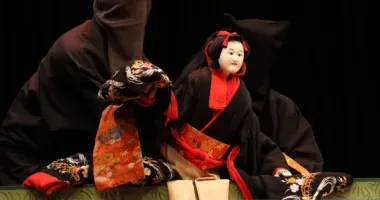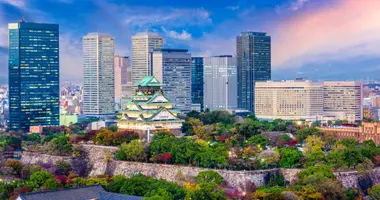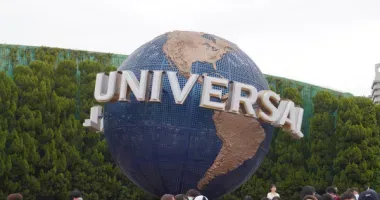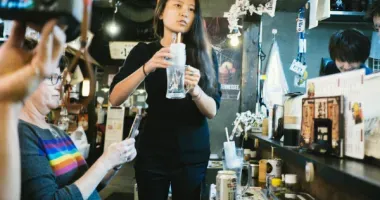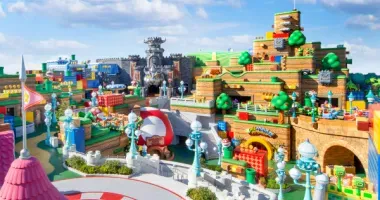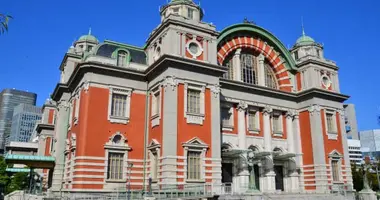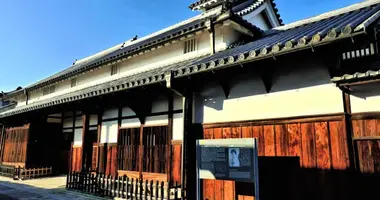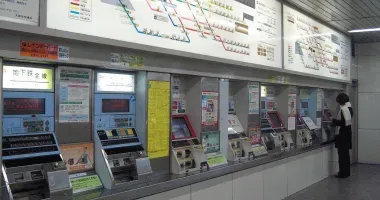Osaka Attractions
- Published on : 24/12/2012
- by : Japan Experience
- Youtube
Osaka Area Guide: Things to Do In Osaka
- Umeda
- Herbis Ent
- Namba
- Namba Parks
- Den Den Town
- Dotombori
- Shinsaibashi
- Tennoji
- Tsuruhashi
- Osaka Castle
- Shitennoji
- Isshinji
- Osaka Zoo
- Tsutenkaku
- Universal Studios
- Hozenji
- National Bunraku Theater
- Osaka Aquarium
- Sumiyoshi Taisha Shrine
- Imamiya Ebisu Shrine
- Osaka Prefectural Gymnasium
- Nagai Stadium
- Museum of Oriental Ceramics
- Osaka Museum of History
- Osaka International Peace Center
- Kyocera Dome Osaka
- Osaka Mint
- Instant Ramen Museum
- Osaka Culturarium at Tempozan
- Human Rights Museum
- Osaka City Museum of Fine Arts
- Farmhouses Museum
- Osaka Maritime Museum
- Osamu Tezuka Manga Museum
- Takarazuka Revue
- Eat & Drink
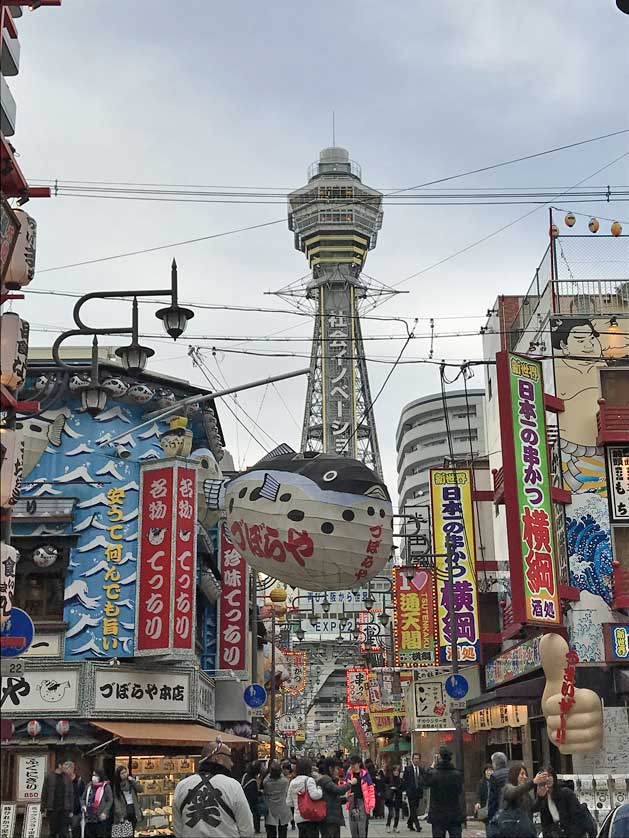
Tsutenkaku Tower, Osaka
Osaka, Japan's third largest city after Tokyo and Yokohama, is the economic heart of western Japan (Kansai) and has a well-deserved reputation as a lively, fun place to visit or live.
Historically, Osaka was Japan's first commercial and industrial hub and the main trade center with the rest of Asia until Tokyo came to predominate in the early 20th century. However, Osaka retains its own distinct identity from the capital, epitomized by its earthy humor and characteristic dialect.
Osaka divides into two quite separate centers: Kita (north) Osaka - the main business district - around Osaka and Umeda Stations and Minami (south) Osaka - the city's entertainment, shopping and nightlife area - around Namba and Shinsaibashi Stations.
The city has much to offer in its own right as well as serving as a convenient base to take in the other main cities in the Kansai area: nearby Kyoto, Kobe and Nara.
Osaka: Areas of Interest
Book Hotel Accommodation in Osaka Here
Umeda
Umeda is Osaka's main commercial and business district and the main point of entry to the city if you are traveling in from Kobe or Kyoto. The twin tower Umeda Sky Building has two observation galleries and an underground re-creation of a Showa-era shopping street - Takimikoji. Below JR Osaka and Hankyu Umeda stations is a labyrinth of underground shopping arcades. At street level the grand Hankyu Department store, the Hankyu Hep Five complex complete with cinemas, restaurants and a funky built-in Ferris-wheel aims at a younger clientele, and the Yodobashi Camera department store is a new addition to the area's shopping scene.
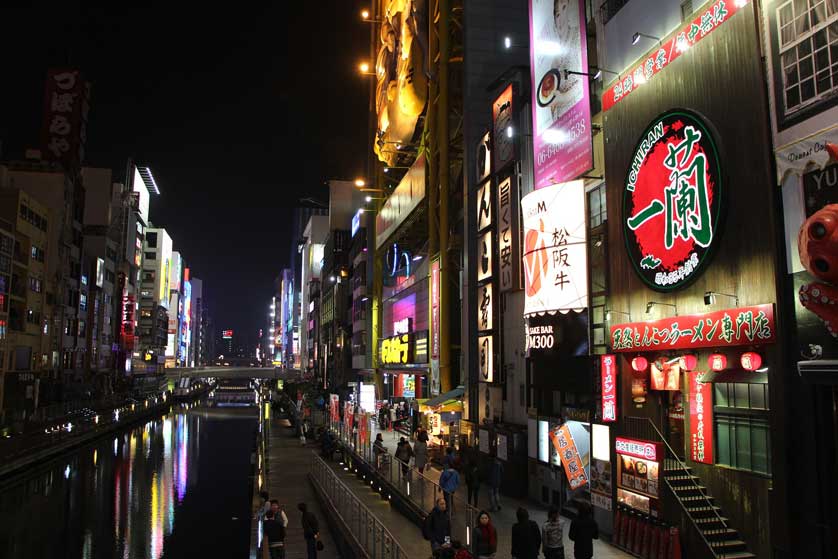
Osaka Neon
Herbis Ent
Herbis Ent, the new complex just south of Osaka Station, has become a magnet for the fashionistas of Osaka. It is a 28-story building just across the street from the Hilton Hotel, and is chock full of brand name boutiques. It is part of the city's ongoing effort to revitalize the Nishi Umeda area. Funded primarily by the Hanshin Electric Group, Herbis Ent is one of many projects in the northern part of the city. JR Osaka Station itself underwent renovations that were completed in 2011, when Osaka Station City, an entertainment and shopping mega-plex, was born. In addition, the Hankyu group is planning to reopen its flagship department store in Umeda. Herbis Ent itself is a 27,000 square-meter complex and consists of 83 tenants.
Namba
Heading south on the Midosuji Subway Line - the city's main north-south artery - brings you to Namba (or Nanba). Namba, like Umeda, has miles of underground shopping arcades including the Namba Underground Shopping Center completed in 1957 - the oldest of its kind in Japan - and the Minami Underground Shopping Center opened in 1971. At street level the 8-storey Namba Parks complex is a new shopping/restaurant development in the area near the more established Takashimaya department store. From Namba station you can take trains to the Buddhist temple retreat of Koya-san and to the beaches and onsen (hot springs) of Wakayama.
Namba Parks
Another Jon Jerde production (the American architect also designed Canal City in Fukuoka, Roppongi Hills, and Caretta Shiodome), the Namba Parks shopping complex was set on the grounds of a derelict baseball stadium in the southern part of central Osaka. With its waterfalls, glass bridges, and open spaces, it, as Time magazine noted, "provides refuge from the city's harsh urban landscape." Within easy walking distance of Namba Station.
Den Den Town
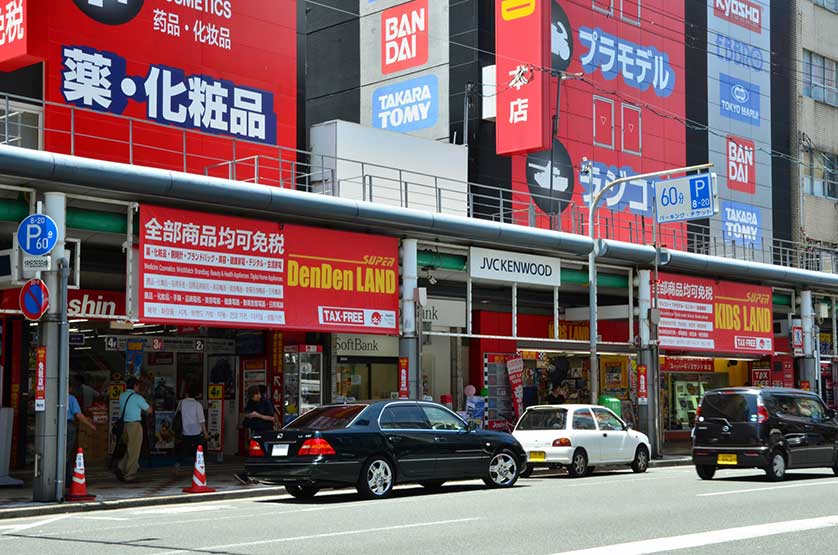
Den Den Town, Osaka
Den Den Town is Osaka's equivalent of Tokyo's electronics and computer paradise Akihabara and is easily accessible from both Namba and Nipponbashi stations (Sakaisuji & Sennichimae subway lines). There's everything here for the hard-core technophile from the latest DVDs and CDs, cameras, computer hardware, software and security systems to second-hand goods, pornography and ripped-off software. The area often has reductions for foreign buyers if you bring your passport and there's a number of cheap cafes and restaurants to cater to the hordes of shoppers. A few of the big stores may have English-speaking and Chinese-speaking staff.
Dotombori
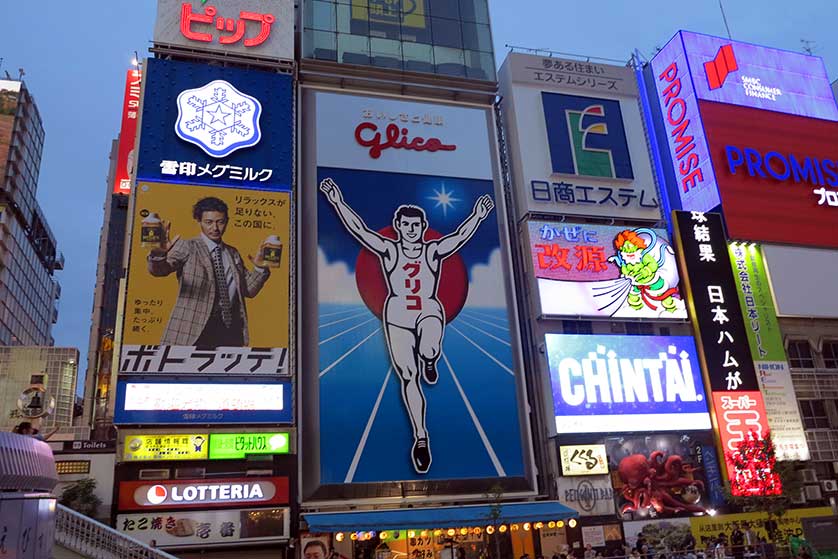
Dotombori
South of the Daimaru department store on Midosuji is the historic entertainment district of Dotombori, running along both sides of the canal that it's named after and dating back to the 17th century. The Ebisu Bridge (popularly known as 'Pick-Up Bridge' or Hikkake-bashi) is famous as a point for the amorous local youth to try their luck, and a place for celebrating sports fans to hurl themselves into the murky waters beneath. The huge red, white and blue 'Glico Man' neon sign is one of the city's most photographed landmarks. The steel and glass Kirin Plaza featured in the gangster movie Black Rain. The area also has a number of theaters including the Shinkabukiza and the Asahiza which hosts performances of bunraku (puppet theater).
Shinsaibashi
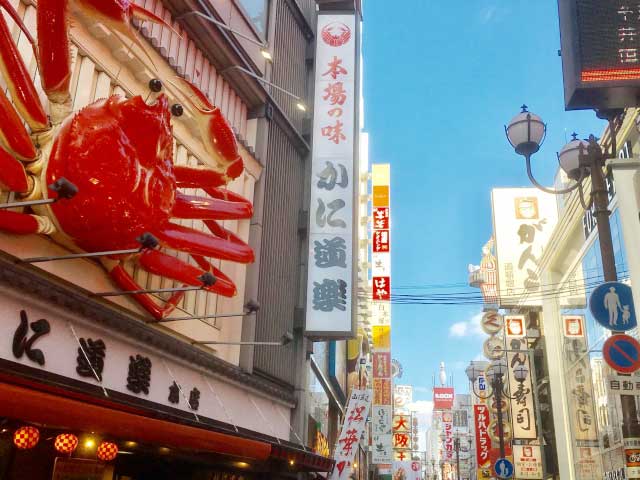
Shinsaibashi
Just north of Namba on the west side of Midosuji is 'Ame-mura' (i.e. American Village): Osaka's foreign-influenced 'street' youth playground with its multitude of ever-changing bars, clubs, boutiques, music stores (including Tower Records) and outlandish street architecture. This is the center of the Shinsaibashi area's late-night party action. The small concrete Triangle Park is the closest the area gets to having a center, and after dark is full of skateboarders, hip-hoppers, and party-goers taking time out to chow down on Osaka's famous octopus dumplings, or takoyaki - all under the eye of the local koban (police box).
On the east side of the boulevard, Shinsaibashi's more mainstream shopping outlets include a branch of Tokyu Hands, the Daimaru department store (with a pleasant roof-top English tea-garden), Parco, OPA, and the Crysta Underground Shopping Mall. Sony Tower displays the electronics giant's latest products. Back on the west side is a Citibank branch too.
Shinsaibashi's area of hip bars, clubs, restaurants and shops is gradually spreading west under the Hanshin Expressway flyover into the more chic Horie as the area develops after the economic slow-down of the late 1990's.
Tennoji
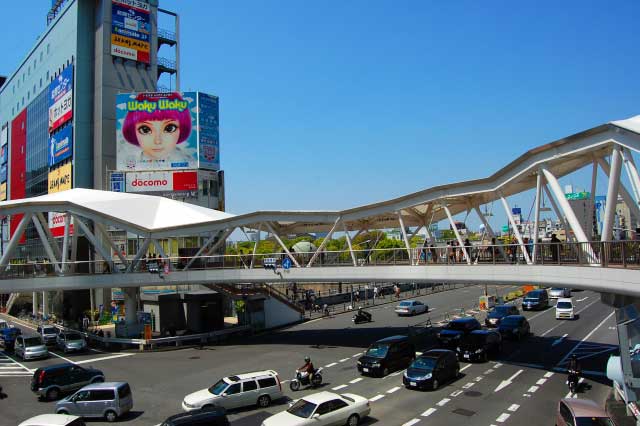
Tennoji
The area surrounding Tennoji and Abeno stations is Osaka's gateway to the southern suburbs and Kansai International Airport (KIX). The district is a beguiling mix of the up-and-coming and the distinctly run-down. There's a multitude of shopping and eating opportunities at Kintetsu department store, the more recent Mio complex, and there's even a branch of New York's Tiffany's. The nearby Tennoji Park includes the city zoo and the Osaka City Museum of Fine Arts. Shitennoji Temple lays claim to being Japan's first state Buddhist temple and Isshinji Temple boasts some amazing modern architecture, designed by none less than the temple's own chief priest and architect, Yasuyuki Takaguchi. Within walking distance of the zoo are Tsutenkaku Tower (modelled after the Eiffel Tower) that marks the center of the seedy Shinsekai ("New World") district, the amusement complex Festivalgate complete with a 100km/h roller-coaster, and the adjoining Spa World: a bathhouse spectacular featuring a variety of spas in European, Middle Eastern and Asian styles.
Tsuruhashi
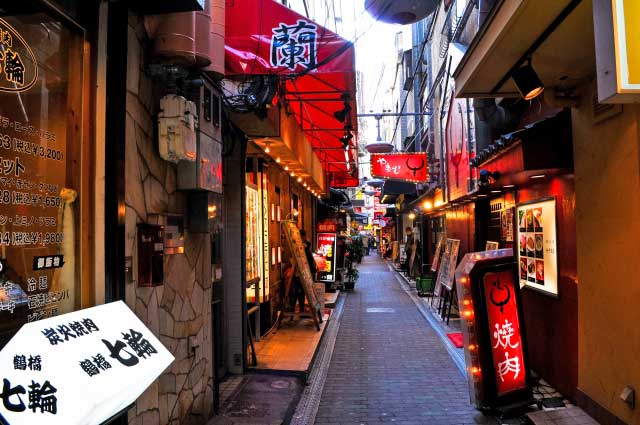
Tsuruhashi
The area surrounding Tsuruhashi (JR Tsuruhashi, Sennichi Mae Subway and Kintestu Tsuruhashi stations) has long been known for its numerous Korean restaurants, markets and Korean shops and the area has become known as "Little Korea".
The narrow alleyways and lanes around the station are an interesting place to wander and soak in the lively atmosphere. People travel from all over the country to sample authentic kimchi, spicy Korean barbeques and to buy colorful Korean costumes and tableware. The thriving market in Tsuruhashi dates back to a post-war black market that grew up in the area and to this day fake designer goods still sometimes appear in Tsuruhashi's maze of shops.
There are also a few shrines and temples within easy walking distance of Tsuharashi station including: Himekoso Shrine, Ubuyu Inari Shrine and Ikaino Shrine.
Parks, Theaters, Theme Parks, Shrines & Temples
Osaka Castle
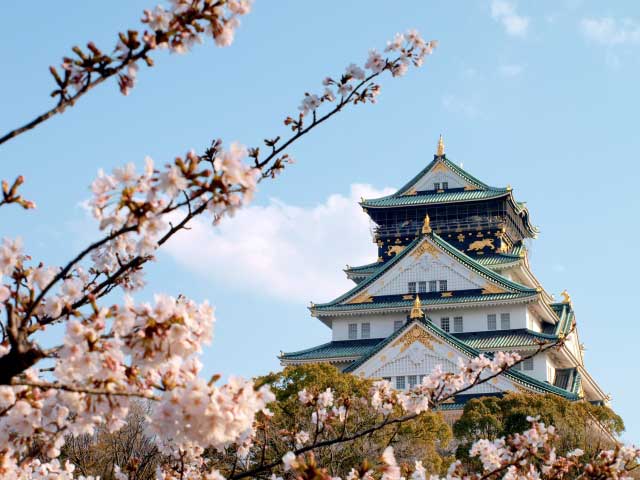
Osaka Castle
Dating from the early 16th century, although completely reconstructed in 1931 and further refurbished in 1997, Osaka Castle (Osaka-jo), is one of Osaka's main tourist attractions. The imposing castle and grounds host a museum dedicated to its founder Toyotomi Hideyoshi and there is a great view of the city from the 8th floor gallery. Set in a large green space which includes Osakajo Hall, the city's premier concert hall, the park also serves as venue to local wannabe bands on weekends. Also within the park are the previous Osaka City Museum building (a western-style structure once the HQ of the 4th division of the Imperial Army) and the Osaka International Peace Center. The main entrance to Osaka Castle, known as 'Ote-mon', is a 10-minute stroll from Tanimachi-yon(4)-chome station on the Tanimachi and Chuo subway lines.
Shitennoji Temple
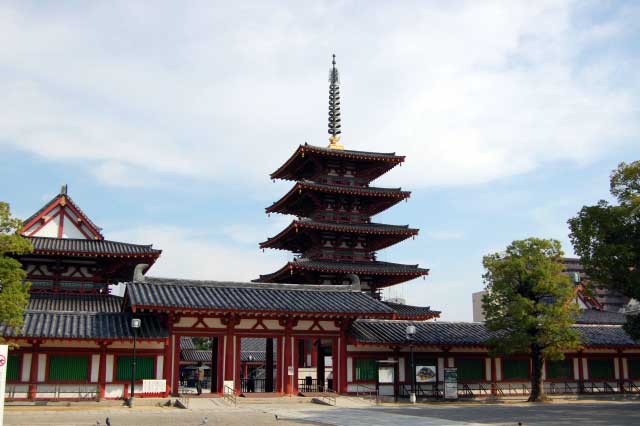
Shitennoji Temple
Shitennoji Temple, mentioned above in the Tennoji section, is Japan's first ever state Buddhist temple dating back to the 6th century, although the oldest remaining structure is a 13th-century torii gate at the main entrance. The temple grounds contain a five-storey pagoda, a treasure house containing ornate mandalas, a tranquil turtle pond and the Gokuraku-jodo Garden. The temple grounds also play host to a monthly flea-market. Five minutes walk from Shitennoji-mae-Yuhigaoka subway station on the Midosuji line.
Isshinji Temple
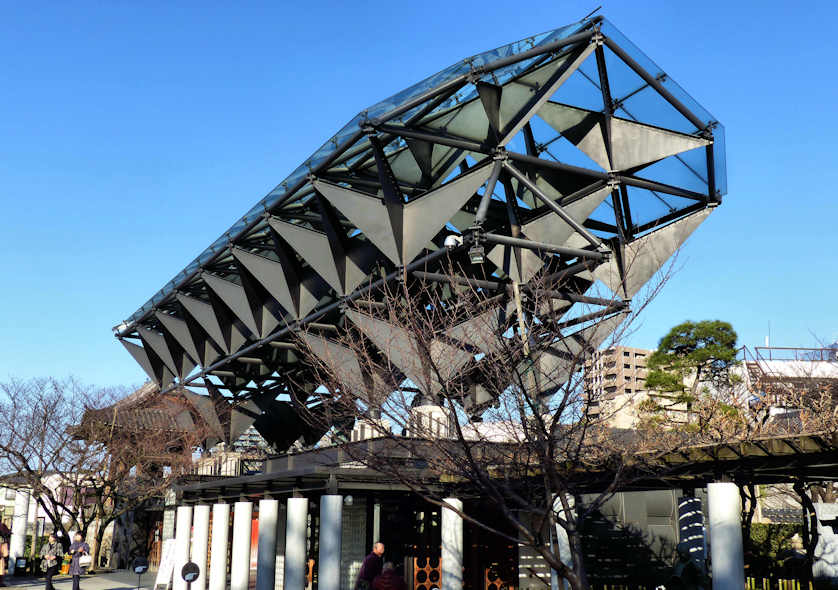
The unusual and unique main gate to Isshinji Temple in Osaka, designed by the current Head Priest
Strikingly modern in its exterior architecture, especially the avant garde steel entrance gates, the compact Isshinji Temple in Tennoji actually dates from the 12th century.
This Jodo sect temple is noted for its fine gardens and as a site to pray to cure alcoholism. Isshinji is also known as a place to lay the ashes of the dead to rest. This tradition dates from a 17th-century battle in Osaka when the bones of soldiers killed in the conflict were cremated here. Access is on foot from from Shitennoji-mae Yuhigaoka subway station on the Tanimachi line (5 minutes) or the JR or subway Tennoji Station (10-15 minutes).
Osaka Zoo
Osaka Zoo in Tennoji Park opened in 1915 and, although it has seen better days, houses a large collection of animals. Access is from Dobutsuen-mae & Ebisu-cho subway stations. Also accessible from JR Tennoji Station. (Ask for directions at the tourist information office at the north exit of the station.)
Tsutenkaku Tower
The 103-meter-tall Tsutenkaku Tower in the now quite shabby Shinsekai (New World) has become a symbol of Osaka.
Tsutenkaku, constructed in 1912, was modeled on the Eiffel Tower. Dismantled during World War II, the tower rose again in 1956. Tsutenkaku is illuminated at night and color-coded lights at the top display the weather forecast.
There is an observation gallery on the 5th floor (91m, 298ft) with fine views of the city and Mt. Rokko in the distance towards Kobe.
The Spa World bath house, open 24 hours, with its 16 baths from 11 different countries is the only reason to draw a visitor to the area after night falls.
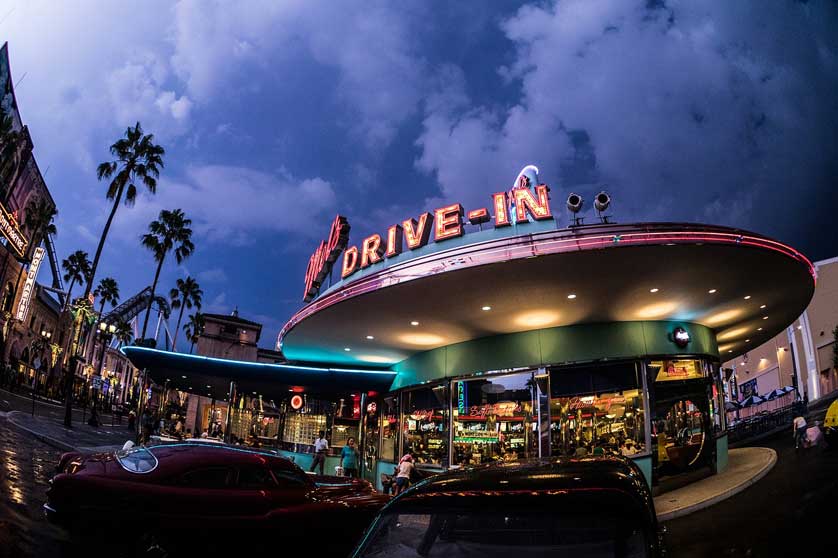
Universal Studios Japan (USJ), Osaka
Universal Studios Japan
Universal Studios Japan opened in 2001 and attracts a steady stream of visitors from all over the country, as well as many tourists from China, South East Asia and Korea. The shows include Back To The Future, ET Adventure, Jaws, Jurassic Park - The Ride, and The Terminator. Access is by train from Nishikujo Station on the JR Loop Line to Universal City Station or by ferry from Kaiyukan West Pier, Nanko Ferry Terminal and Nanko Cosmo Pier.
Hozenji Temple
Hozenji Temple is a tiny temple popular with workers in the adjacent entertainment area of Dotombori (see above) who pour water onto the moss-covered statue of Fudo-myo to ensure an auspicious night out. Nearby is Hozenji Yokocho - an alley of traditional bars and eateries.
National Bunraku Theater
Bunraku - Japanese puppet theater - became extremely popular with the merchant class in Osaka from the 17th century onwards. The National Bunraku Theater, which opened in 1984, is the nation's mecca for the art and hosts performances throughout the year. Access is from Nipponbashi Station exit #7 on the Sennichimae and Tanimachi subway lines. English guides are available.
Osaka Aquarium
Situated in the Osaka Port area of Tempozan, Osaka Aquarium (Kaiyukan) is one of Japan's best. Visitors can view the 15 Pacific Ocean tanks as they travel down on escalators from the 8th floor. A whale shark is the pride of the exhibits. Take the Chuo subway line to Osaka-ko Station.
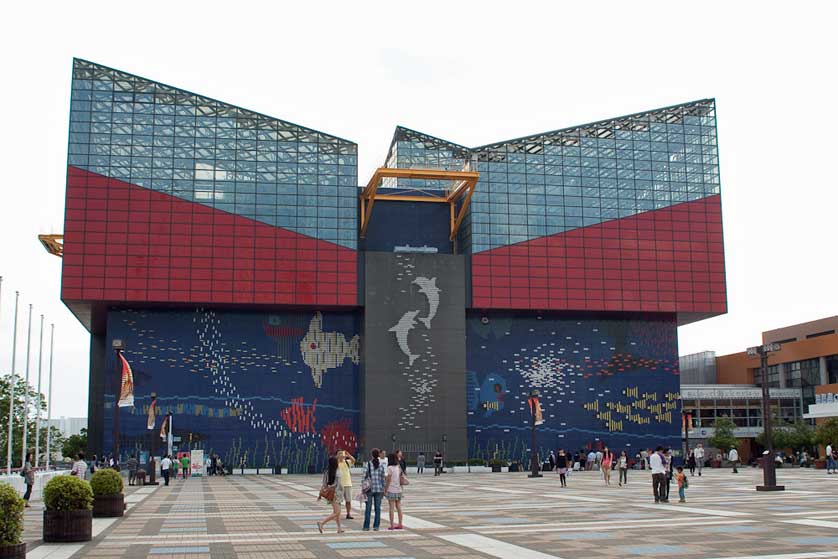
Osaka Aquarium, Kaiyukan, Tempozan, Osaka
Sumiyoshi Taisha Shrine
Supposedly dating all the way back to the 3rd century, Sumiyoshi Taisha is a shrine dedicated to the gods of the sea. Many of the stone lanterns that line the approach to the shrine have been donated by sailors and ship owners. The arched bridge in the grounds is said to be a gift from Hideyoshi Toyomi's lover Yodogimi. Just west of the shrine is Sumiyoshi Park. It is possible to ride Osaka's last remaining tram on the Hankai Line from Tennoji Station to Sumiyoshi-tori-mae or take the Nankai Line to Sumiyoshi station.
Imamiya Ebisu Shrine
North-west of Tsutenkaku Tower is Imamiya Ebisu shrine which is dedicated to the sun goddess and other gods of good fortune. The shrine's main festival is in early January and attracts large numbers of business people and shopkeepers who come to pray for a successful financial year.
Osaka Prefectural Gymnasium
Osaka Prefectural Gymnasium built in 1952 hosts Osaka's annual sumo tournament in March, as well as numerous pro wrestling, taekwondo and K-1 bouts. The gymnasium is also a major venue for volleyball, basketball and gymnastics.
Access: Osaka Prefectural Gymnasium is within easy walking distance of three Namba stations: west of Nankai Namba station, south of Kintetsu Namba station and south-east of JR Namba station. Sumo ticket information is available from the Nihon Sumo Kyokai.
Nagai Stadium
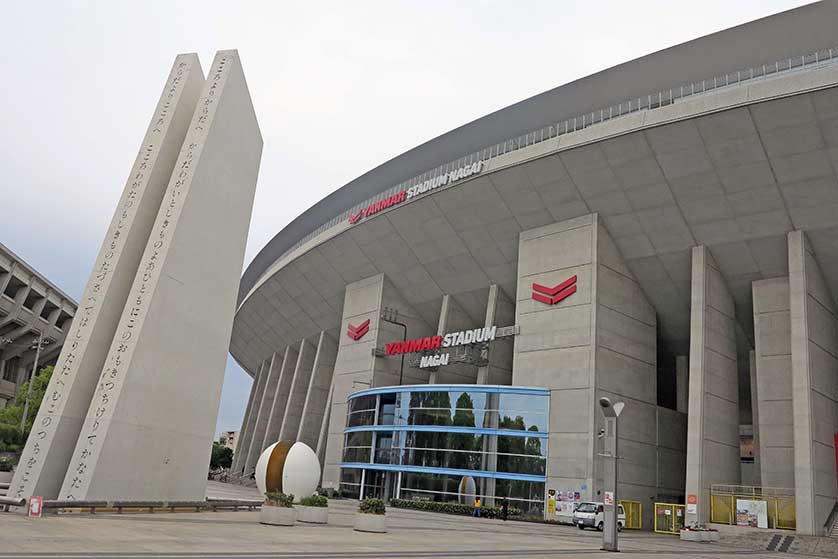
Nagai Stadium
Nagai Stadium in Nagai Park is the home of the J. League's Cerezo Osaka professional soccer team. The huge concrete bowl was refurbished for the 2002 World Cup and holds over 45,000 spectators. The ground sells out only for international matches, so tickets are usually readily available on ordinary match days.
Nagai Stadium and Nagai Park are 5 minutes on foot from three stations: Tsurugaoka Station and Nagai Station on the JR Hanwa Line from Tennoji, and Nagai Station (exits 1 & 3) on the Midosuji subway line.
Osaka Museums
Museum of Oriental Ceramics
The Museum of Oriental Ceramics in the Nakanoshima district houses a world-class collection of mainly Chinese and Korean pottery.
Admission : Adults 500 yen/Students 300 yen
Open 9.30am - 5pm (last admission until 4.30pm). Closed Mondays, the day after a national holiday, and for the week around New Year. (May be closed at other times for exhibition preparations.)
Location: the east side of the Chuo Kokaido in Nakanoshima Park. 5 minutes on foot from Yodoyabashi Station on the Midosuji Subway line or Keihan line, or Kitahama Station on the Sakaisuji Subway line or Keihan line.
1-1-26 Nakanoshima, Kita-ku, Osaka-shi 530-0005
Tel 06-6223-0055 Fax 06-6223-0057
Osaka International Peace Center
Also situated in Osakajokoen, Osaka International Peace Center (Peace Osaka) has exhibits detailing the effects of World War II on the city - including a reproduction of a 1-ton US bomb. Access is from Morinomiya station on the JR Loop Line (Kanjosen). Closed Monday.
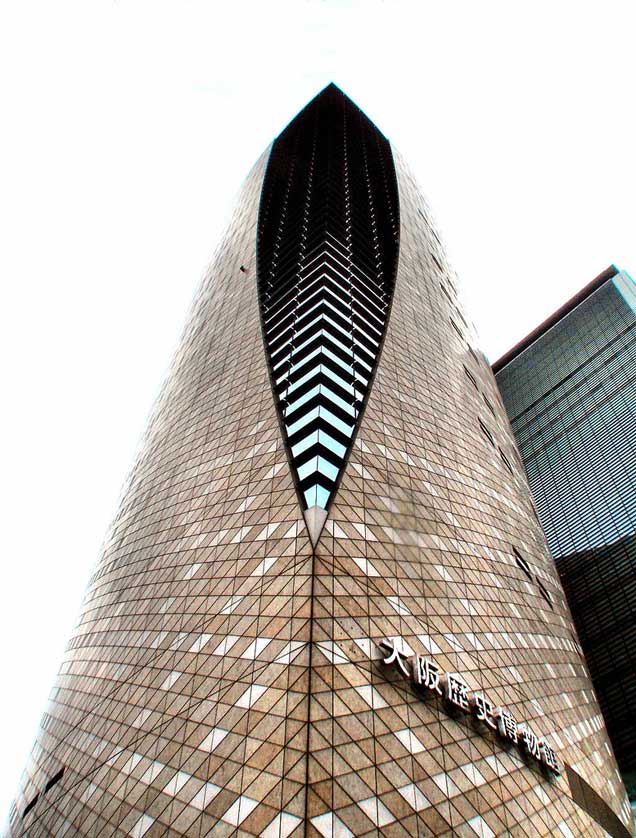
The Osaka Museum of History is inside a modernist tower
Osaka Museum of History
Osaka Museum of History is housed in a modernistic multi-storey tower, adjacent to the Osaka NHK Broadcast Center. There are great views of Osaka Castle and the city below from the top floors of the museum, worth the price of admission alone.
Osaka Museum of History opened in 2001 and is dedicated to the history of Osaka from ancient to modern times. The Osaka Museum of History is a short walk from Exit 9 of Tanimachi 4-Chome Station on the Tanimachi and Chuo lines of the Osaka subway and close to the Remains of Naniwa-no-miya Palace. Hours: 9.30am-5pm (Fridays 9.30am-8pm), closed Tuesday. Admission: Adults 600 yen; students 400 yen. Tel: 06 6946 5728.
Kyocera Dome Osaka
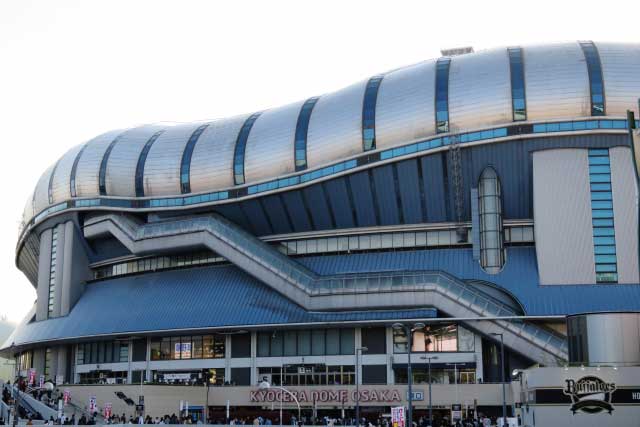
Kyocera Dome Osaka
Osaka Dome now known as "Kyocera Dome Osaka" until March 31 2011 is the home baseball stadium of the Orix Buffaloes and a venue for big-name rock concerts, trade fairs and other events. The dome opened in 1997 and is open during the day with a number of shops and restaurants on site.
Access is from Dome-mae Chiyozaki Station on the Osaka City Subway Nagahori Tsurumi-Ryokuchi Line, Taisho Station on the Osaka Loop Line or Kujo Station on the Osaka City Subway Chuo Line.
Google Map
Osaka Mint
Osaka Mint Bureau - Zoheikyoku - opened in 1871 and has a museum with a large collection of Japanese coins and medals. It is also possible to see something of present-day production methods on a tour of the mint with advance booking: tel. 06-6351-6150. Both the tour and the museum are open Monday through Friday and admission is free. The grounds of the Mint along the Yodo River are opened to the public for a short period in spring so visitors can enjoy over 100 varieties of cherry trees in full bloom. Access is from Tenmabashi station on the Tanimachi subway line or Keihan line, or from Minamimorimachi station on the Tanimachi or Sakaisuji subway lines.
Google Map
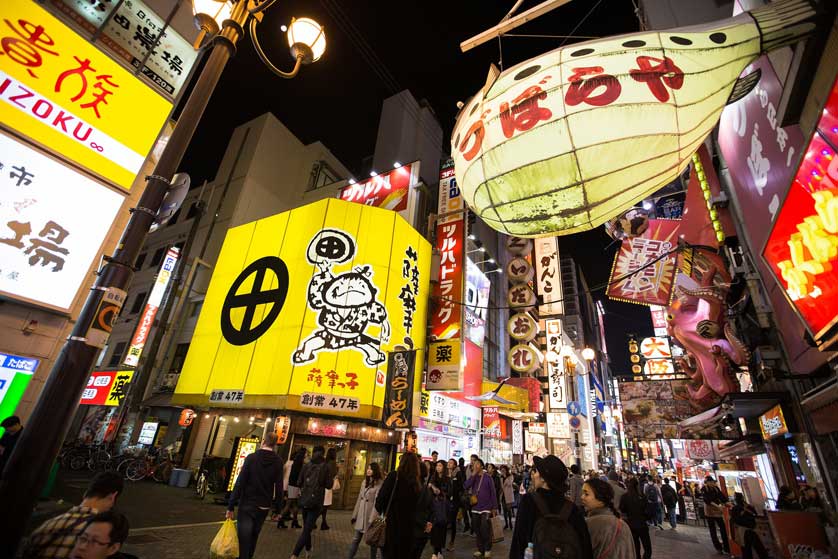
Dotombori, Osaka
Instant Ramen Museum
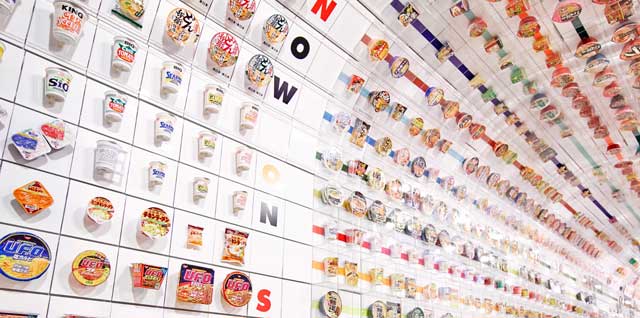
© Momfuku Ando Instant Ramen Museum; Ramen tunnel inside the Momfuku Ando Instant Ramen Museum
The Instant Ramen Museum is quirky museum dedicated to one of Japan's most popular institutions - instant ramen - and its inventor Momofuku Ando. Ando brought cup noodles to the world in 1958. There's a replica of the great man's workshop shack and everything else you need to know about the man and his product. Admission free. Closed Tuesdays. Access from Ikeda Station on the Hankyu-Takarazuka Line.
Read more on Momofuku Ando & the Instant Ramen Museum
Osaka Culturarium at Tempozan (formerly the Suntory Museum
The Osaka Culturarium at Tempozan, designed by architect Tadao Ando, is located in the Osaka port area near Osaka Aquarium. In its initial incarnation from 1994 as the Suntory Museum, it had a collection of modern art, over 10,000 posters and an IMAX theater. There were also special exhibitions throughout the year. The Suntory Museum closed in 2010 and reopened as the Osaka Culturarium at Tempozan and continues as a venue for displays of large and striking collections from around the world.
Osaka Human Rights Museum / Liberty Osaka
The Osaka Human Rights Museum which is also known as Liberty Osaka is dedicated to Japan's oppressed minorities: burakumin (untouchables), Koreans, the physically-challenged, Ainu and women. There are also exhibits on war and the effects of environmental pollution, dealing with the infamous Minamata disease incident. There are video presentations and materials available in English. Access from Ashiharabashi Station on the JR Loop line. Entrance is presently 500 yen for adults. Closed Monday.
Osaka City Museum of Fine Arts
The Osaka City Museum of Fine Arts located a few minutes north of Tennoji Station houses a collection of both ancient and modern Oriental art. The museum also puts on special exhibitions throughout the year. Access from JR Tennoji station and subway stations. Closed Monday.
The Open Air Museum of Old Japanese Farmhouses
Not quite what you would expect in a big city, but Ryokuchi-koen has a collection of 11 gassho zukuri (thatched-roof) farm houses brought from all over the country. There's even an outdoor kabuki theater. Access from Ryokuchi-koen Station on the Midosuji Line. Closed Monday. Entrance is presently 500 yen for adults.
Osaka Maritime Museum
The Osaka Maritime Museum Closed In 2013

Osaka Maritime Museum
Housed in a futuristic dome, the Osaka Maritime Museum in the Osaka port district traces the importance of the sea in the commercial history of Osaka as well as the many rivers and canals in a city once known as "the Venice of the East". There are exhibits of figureheads and maritime art. Access from Cosmo Square subway station. Closed Monday.
Osamu Tezuka Manga Museum
The Osamu Tezuka Manga Museum in Takarazuka in nearby Hyogo Prefecture is a shrine to the King of Manga. The prolific Osamu Tezuka, who spent his childhood in Takarazuka, created Astro Boy (or Atomu in Japanese), Kimba the White Lion, and much more in his career as an illustrator and manga artist. Many years after his death he is still revered in Japan. The Osamu Tezuka Manga Museum is open from 9:30 am-5 pm. Access by Hankyu and JR Lines from Umeda Station.
Adults: 700 yen.
Junior high & high school students: 300 yen
Elementary school children: 100 yen.
Tel: 0797-81-2970
Takarazuka Grand Theater
Takarazuka is also the home of the 700-strong, all-female Takarazuka Review Company. Founded in 1914, Takarazuka's saccharine mix of clean-cut romance and outrageous spectacle continues to appeal to a mass audience of mainly young female fans who flock in their millions to see the performances of dance reviews and musicals. Stars of the show are the otoko-yaku - women who play the male leads.
Eat and Drink
Osaka has a reputation as a gourmet city and as well as classic Japanese cuisine it's possible to sample food from around the world. Restaurants in Osaka range from authentic Korean food in Tsuruhashi's 'Korea Town' to excellent Indian food in Umeda, Shinsaibashi and Honmachi. After dark, Shinsaibashi and neighboring Horie to the west are the places to go for some of Japan's most atmospheric and friendly bars and clubs.
Bars, Cafes & Restaurants in Osaka Recommended (by area)
Umeda & Minoh
Banjara Indian Restaurants
Sam & Dave's Club: Umeda Branch
Shinsaibashi
Cinquecento Martini Bar
Covent Garden Social Club Bar
Murphy's Irish Pub
Sam & Dave's Club
Osaka Map
Guide Books on Japan
Osaka attractions: see a listing of Osaka temples & shrines, museums, Osaka festivals, shopping, bars, restaurants and clubs.
